John Wayne in Utah
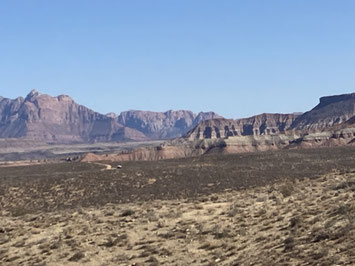
John Wayne first worked in Utah on The Big Trail, they took some canyon footage near St. George, utilizing the rimrock country of Hurricane Cliffs.

The Big Trail's brief flashback sequence was shot on the rimrock country above the little town Hurricane, called the Hurricane Cliffs. This is situated in close vicinity of Zion National Park (this is why Zion itself is often given as a John Wayne location, which it is not).
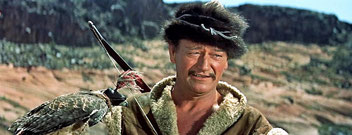
John Wayne would return to St. George almost a quarter of a century after the brief flashback scene for The Big Trail. For 1955' The Conqueror, ten shooting sites around St.George were chosen. Click the image to get to the Snow Canyon section.
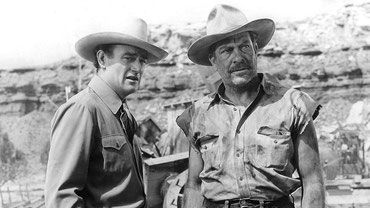
In Old Oklahoma (aka War of the Wildcats, here with his old buddy Grant Withers) was in production on Utah locations between June 28 and September 4, 1943. The John Wayne western was headquartered in Kanab. The plot deals with oil drilling and Republic was able to construct a set where oil fields still existed, near the small town of Virgin, in the scenic area of Washington County. A trail winds down from Kanab into the Kanab Canyon, off Highway 89. The dirt road leads five miles to the Paria Canyon, one of the most most beautiful of western locations.

At the Union Pacific train depot, in the west of Cedar City, John Wayne’s cowboy character is introduced in In Old Oklahoma, as he gets on the special train uninvited.

The production of In Old Oklahoma was probably the first time John Wayne stayed at the now-famous Parry Lodge in Kanab. The colonial-style hotel at 89 East Center Street with its columned structure got started in 1931. The Parrys would house and feed the movie crews for decades. A „John Wayne Room“ and more than 250 autographed photos in the lobby are a reminder to the Parry’s glory days when Kanab established a reputation as „Little Hollywood“.

John Ford had discoverd Moab for Wagonmaster. In the spring of 1950, he returned for Rio Grande and the first pairing of John Wayne and Maureen O’Hara. The director used the same locations as in the first film, Professor Valley at State Route 128 and the region of the Fisher Towers on the Colorado River. The majority of the crew arrived on June 14, 1950 at Moab airport.
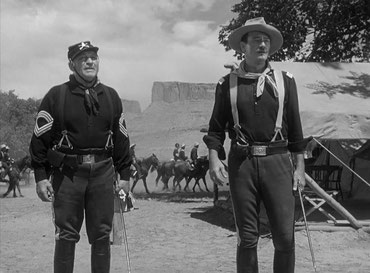
John Ford utilized the George White Ranch for the Rio Grande fort. The fort set was reused in later westerns (like Taza, Son of Cochise, starring Rock Hudson) and then dismantled. The George White Ranch is now the location of Red Cliffs Lodge, Milepost 14, Hwy 128. The lodge also maintains the Moab Museum of Film and Western Heritage.

John Ford built the set of the pueblo village in Castle Valley, located fourteen miles east of Moab off State Route 128. The pueblo was located between Castle Rock and Fisher Towers. This often-reproduced photo is not from a scene in the film, it was staged for a publicity shot and John Wayne's image was then used for the artwork of the posters.

John Ford often put Castletown Tower in the background. He filmed John Wayne’s cavalry fording the Rio Grande (a shallow area of the Colorado) at the gravel Site at Ida Gulch (one mile east of the junction of Castle Valley Road and State Route 128, milepost 16).

John Wayne as Kirby Yorke leads his determined Rio Grande troopers through a canyon; that is the Onion Creek Narrows.

On June 18, 1961, John Wayne was back in Moab for the rousing The Comancheros. Wayne and other cast members stayed at the Apache Hotel in Moab, at 166 Fourth E St., usually in room 34 when he was alone, room 20 when his family accompanied him.

For The Comancheros twenty-three buildings were constructed for the outlaw camp in Professor Valley. The largest one was the stucco-and-tile headquarters of the Comanchero boss, on a flat in the shadow of Fisher Towers, on milepost 21.
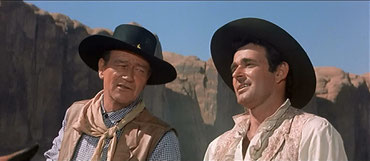
The canyon walls of King’s Bottom provided the background for the dialogue scene in The Comancheros in which John Wayne’s Texas Ranger reminds Stuart Whitman’s gambler, „Mon-sewer, words are what men live by.“ King’s Bottom is now a campground, three miles from downtown Moab.
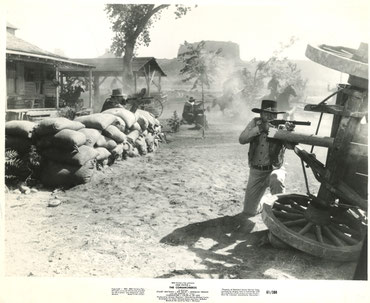
The farm that is attacked by the notorious Comancheros was set on a plateau right on the shores of the Colorado. The Comancheros was John Wayne's final Utah film.
©All text content on this website is protected by copyright and other intellectual property laws. No part may be reproduced without the prior written permission. All photos courtesy of Roland Schaefli, unless otherwise stated.
This website is in no way associated with the John Wayne Estate or business enterprises. Go to johnwayne.com to find the official website and to https://johnwayne.org/ to read about the wonderful John Wayne Cancer Foundation.
more john wayne locations to scout
If you like this site, you'll like the book: the first comprehensive guide to the John Wayne Locations, with hundreds of then-and-now photos, unpublished behind-the-scenes-pictures and detailed tour descriptions
Tracking John Wayne: The complete Tourguide
Find directions to locations and anecdotes from the Duke's movie sets in this new publication from McFarland, available at bookstores and online shops
For all locations mentioned on this website, the book offers behind-the-scenes stories, making-of anecdotes and never before published photos

